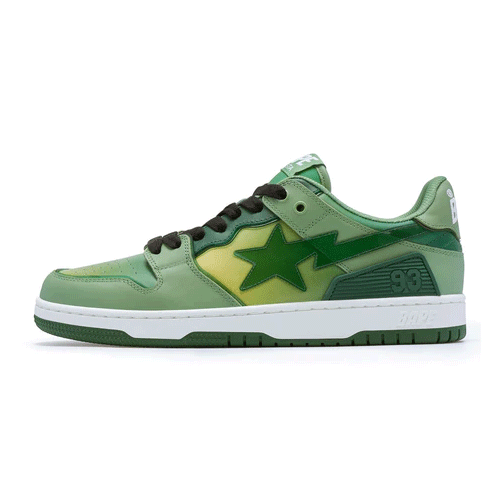When it comes to legendary sneakers that have shaped the streetwear landscape, few have had the cultural impact of the Bapesta. Designed by Japanese fashion brand A Bathing Ape (BAPE), the Bapesta isn’t just a shoe — it’s a statement. A symbol of rebellion, celebrity status, and bold creativity, the Bapesta carved its own space in the fashion world by blending high-end design with street-level credibility.
In this article, we’ll dive into the origins of the Bapesta, how it became a streetwear essential, and why it remains a powerful force in today’s sneaker culture.
The Origins of Bapesta: A Bold Move by Nigo
The Bapesta was introduced in the early 2000s by Nigo, the founder of BAPE. Known for his love of American pop culture, hip-hop, and vintage sneakers, Nigo sought to create something that would pay homage to the past while pushing boundaries.
He drew heavy inspiration from the Nike Air Force 1 — a fact that quickly caught attention across the sneaker industry. The resemblance was unmistakable: the low-cut silhouette, chunky sole, and even the side panel design. But instead of Nike’s Swoosh, Bapesta featured a signature star-shaped logo, often stylized as a lightning bolt, known as the “STA.” This distinct branding turned the sneaker from imitation to innovation.
The move was controversial but genius. While some criticized the design as derivative, others saw it as a bold reinterpretation — a Japanese remix of an American classic. The result? A new cult classic was born.
From Tokyo to the World: The Rise of Bapesta in Pop Culture
What truly propelled the Bapesta from niche to mainstream was its endorsement by celebrities and hip-hop artists. In the early to mid-2000s, major artists like Pharrell Williams, Kanye West, Soulja Boy, and Lil Wayne began rocking the sneakers. At a time when BAPE was still considered underground outside Japan, seeing American icons wearing the brand added instant clout.
The Bapesta’s vibrant colorways and patent leather finishes made it stand out in music videos, concerts, and street style shots. Unlike traditional sneaker color palettes, Bapesta embraced bold pinks, greens, camo prints, and metallics — turning the shoes into wearable art.
This cultural crossover introduced BAPE to Western audiences and embedded the Bapesta into the DNA of hip-hop fashion.
Design Aesthetics: Why Bapestas Are Unmistakable
One of the biggest reasons for Bapesta’s continued relevance is its unapologetic design language. It’s not a sneaker that tries to blend in — it demands attention.
The colorways are often wild, mismatched, or layered with the brand’s iconic camouflage. The materials range from glossy patent leather to suede and canvas, with limited-edition drops featuring collaborations with artists, musicians, and designers. Each release feels like an event, adding to the sneaker’s exclusivity.
Even the packaging is part of the experience. Bapestas often come in shoeboxes that resemble candy packaging or retro designs — small but significant touches that elevate the unboxing ritual for collectors.
Collaborations and Limited Drops: Keeping the Hype Alive
The Bapesta’s longevity in the sneaker market is partly due to its strategy of limited releases and high-profile collaborations. Over the years, BAPE has teamed up with some of the biggest names in pop culture and fashion.
Notable collaborations include partnerships with Kanye West (known as the “College Dropout” Bapesta), Marvel Comics, SpongeBob SquarePants, Comme des Garçons, and Undefeated. Each collab introduced fresh takes on the silhouette while tapping into new fan bases.
These collaborations weren’t just marketing gimmicks — they were cultural events. The exclusivity of certain models made them instant collector’s items, with resale prices often soaring on secondary markets.
Bapesta vs. Air Force 1: Imitation or Innovation?
The Bapesta has always drawn comparisons to the Air Force 1 — for obvious reasons. But over time, sneakerheads began to see the two as distinct cultural artifacts. The AF1 is rooted in basketball and American street culture, while the Bapesta grew out of Tokyo’s eclectic fashion scene.
Bapesta’s design is more playful, more colorful, and often more experimental. While the AF1 has become a staple that works with almost anything, the Bapesta is for those who want to stand out and signal a deeper understanding of streetwear history.
And unlike the AF1, which has seen countless general releases, Bapesta’s availability is intentionally limited — enhancing its appeal among collectors.
The Resurgence of Bapesta in Modern Fashion
In recent years, the Bapesta has made a strong comeback. With nostalgia driving much of today’s fashion, sneaker fans have returned to early-2000s icons — and the Bapesta is leading the charge.
Gen Z and younger Millennials, many of whom grew up seeing the Bapesta in music videos or magazines, are rediscovering its charm. At the same time, new collaborations and global drops have introduced the silhouette to a new generation of fashion-forward consumers.
Streetwear giants like Supreme, Off-White, and Travis Scott’s Cactus Jack brand have shown how nostalgia and innovation can coexist. The Bapesta fits perfectly into this movement — a retro sneaker with modern appeal.
Styling the Bapesta: Fashion Tips for Sneakerheads
The Bapesta isn’t for subtle looks — it thrives when styled boldly. Pair it with oversized graphic tees, distressed denim, cargo pants, or full BAPE tracksuits for an authentic Y2K vibe.
If you prefer a more modern twist, Bapestas also work well with minimalist fits. Let the sneakers be the focal point by keeping the rest of your outfit muted. Whether it’s a high-fashion look or casual streetwear, the key is confidence — these shoes were made to be seen.
Caring for Your Bapestas: Keeping Them Fresh
Because many Bapestas use patent leather, proper care is essential. Store them away from direct sunlight to avoid yellowing, and always clean them with soft, non-abrasive materials. A soft brush and warm soapy water can do wonders for everyday cleaning. For high-value pairs, consider investing in sneaker shields and silica gel packs to maintain shape and freshness.
Keeping the original box and tags also increases the sneaker’s resale value — important for collectors.
Why Bapesta Still Matters
The Bapesta represents more than just fashion. It symbolizes an era, a cultural shift, and the global language of streetwear. It’s the result of fearless design, cultural blending, and boundary-pushing creativity.
From Tokyo’s Harajuku streets to sneaker closets around the world, the Bapesta has proven it’s more than a trend — it’s a legacy. And as long as streetwear continues to evolve, the Bapesta will remain one of its most iconic and beloved staples.
Final Thoughts
Whether you’re a seasoned sneakerhead or new to the streetwear scene, the Bapesta offers a rich story of design, rebellion, and cultural crossover. It challenges conventions, honors hip-hop history, and proves that bold ideas can redefine fashion.
If you’re looking to expand your sneaker rotation with something loud, legendary, and full of history — the Bapesta might just be the perfect pair.






